External Temperature Distribution and Characteristics of Building-Integrated Photovoltaics (BIPV) Under Summer High-Temperature Conditions
Abstract
1. Introduction
2. Data and Methods
2.1. Measurement Object
2.2. Measurement Scheme
2.2.1. Measurement Instruments
2.2.2. Measurement Point Layout
- (1)
- Outdoor parameter measurement:
- (2)
- Building PV module surface temperature measurement:
2.3. Measurement Time and Data Processing
2.3.1. Measurement Time and Spatial Classification
- High-temperature days: 7 days;
- Typical high-temperature days: 2 days;
- Day/night periods: 2 periods;
- Characteristic periods: 3 periods.
- Near surface: 0~10 cm;
- Short distance: 10~40 cm;
- Medium distance: 40~80 cm;
- Long distance: >80 cm.
2.3.2. Data Collection and Processing
- Daily maximum temperature, daily minimum temperature, and average temperature.
- Daily temperature variation rate: This is the variation amplitude between maximum and minimum temperatures.
- Relative temperature increment: This is the difference between the measurement point temperature and simultaneous ambient temperature.
- Heating/cooling rate: This is the ratio of the temperature difference to time over a period.
- Temperature gradient: This is the ratio of the temperature difference between adjacent measurement points to distance.
3. Results
3.1. Overall Thermal Effects on High-Temperature Days
- Daytime heating effect (DHE):
- 2.
- Nighttime cooling effect (NCE):
- 3.
- Surface temperature characteristics:
- 4.
- Net thermal effect intensity (NTE):
3.2. Temperature Temporal Distribution Under High-Temperature Weather
3.2.1. Daytime Temperature Variation
- Heating period (6:00–13:00):
- 2.
- High-temperature period (13:00–17:00):
- 3.
- Evening cooling period (17:00–20:00):
3.2.2. Nighttime Temperature Temporal Distribution
3.2.3. Temporal Distribution Characteristics of Temperature
- Thermal response lag:
- 2.
- Thermal inertia:
- 3.
- Comprehensive thermal effect comparison:
3.3. Temperature Spatial Distribution Under High-Temperature Weather
3.3.1. Daytime Temperature Spatial Distribution
- Building geometry effects: Due to right-angle geometry formed by vertical facade structures and the ground, airflow recirculation occurs at specific distances.
- Thermal plume effects: Ascending airflow produced by heated surfaces is blocked by ambient crosswinds at medium distances, forming vortices where the heat residence time is extended.
- Turbulent mixing effects: Interactions between near-surface small-scale thermal convection and ambient large-scale wind fields form vortex stagnation zones at specific distances, reducing heat transfer efficiency.
3.3.2. Nighttime Temperature Spatial Distribution
3.3.3. Temperature Spatial Distribution Characteristics
- Nonlinear distribution: BIPV external temperatures exhibit complex fluctuation phenomena in spatial distance rather than a linear decreasing distribution. The study used segmented methods to explain the temperature characteristics and dominant mechanisms in different distance regions.
- Thermal influence range: Based on temperature difference analysis, the main influence range of BIPV thermal effects is 60–80 cm. Within this range, all measurement point temperatures showed significant differences from the ambient temperature, with differences gradually decreasing beyond this range and approaching ambient conditions.
- Local heat accumulation: During high-temperature days, local temperature peaks are measured at approximately 60 cm from the surface, with average peak temperatures 0.4–0.8 °C higher than adjacent measurement points, forming local heat accumulation phenomena. Dominant mechanisms for heat accumulation under different wind speed characteristics are determined: Ri < 0.3 for building geometry dominance, 0.3 ≤ Ri ≤ 0.7 for the mechanism transition zone, and Ri > 0.7 for thermal plume dominance.
3.4. Environmental Parameter Influences
3.4.1. Radiation Intensity Influence
3.4.2. Wind Speed Influence
3.4.3. Ambient Temperature Influence
4. Discussion
4.1. Main Findings
4.1.1. Dual Characteristics of BIPV Thermal Effects
4.1.2. Nonlinear Characteristics of Temperature Distribution
4.1.3. Critical Regulatory Role of Wind Speed
4.2. Analysis of Physical Mechanisms
4.2.1. Heat Transfer Mechanism Dominance in Spatial Distribution
- Building-geometry-dominated mechanism (Ri < 0.3):
- Thermal-plume-dominated mechanism (Ri > 0.7):
- Mechanism transition zone (0.3 ≤ Ri ≤ 0.7):
- (1)
- Temperature Applicability: This study was developed under high-temperature conditions of 35–37 °C and is theoretically applicable to weather ranges with maximum temperatures of between 35 and 40 °C. Critical thresholds may deviate under extreme heat (>40 °C) or relatively mild conditions (<35 °C).
- (2)
- Geographic Applicability: This study was developed for a location at 36.7° N latitude. For regions with latitude differences exceeding 10°, variations in solar radiation incidence angles may affect surface temperature distribution. Adjustments should be made based on local solar elevation angles.
- (3)
- Building Scale Applicability: This study applies to small single-story BIPV buildings with heights of 3–6 m and aspect ratios of around 0.6–1.5. For high-rise or irregularly shaped buildings, the critical values require recalibration.
4.2.2. Heat Transfer Mechanism Evolution in Temporal Distribution
4.2.3. Radiation Mechanisms of Nighttime Cooling
4.3. Limitations of the Study
- Limitations of the Research Subject:
- 2.
- Limitations of Measurement Design:
4.4. Application and Guidance Significance
4.4.1. Scientific Significance
- Understanding Physical Mechanisms:
- 2.
- Revealing Heat Transfer Theory:
4.4.2. Guidance for Engineering Projects
- BIPV Building Design Optimization Strategies:
- 2.
- Urban Thermal Environment Assessment:
- 3.
- Heat Recovery and Utilization Potential:
5. Conclusions
- (1)
- This study confirmed nonlinear characteristics of BIPV external temperature distribution, with 77% of high-temperature days showing local heat accumulation phenomena approximately 60 cm from the surface, with the maximum accumulation intensity reaching 0.8 °C.
- (2)
- This study established modified Richardson criteria for BIPV buildings: Ri < 0.3 for building geometry dominance, 0.3 ≤ Ri ≤ 0.7 for the mechanism transition zone, and Ri > 0.7 for thermal plume dominance.
- (3)
- This study revealed thermal effects under different meteorological conditions. For example, the BIPV external net thermal effects were +3.43 °C on August 3 and −0.52 °C on August 22. The net thermal effects strongly correlated with meteorological conditions. This correlation resulted from varying degrees of daytime heating and nighttime cooling.
- (4)
- This study determined different influence mechanisms of solar radiation, wind speed, and ambient temperature on BIPV thermal effects, providing a basis for optimizing thermal environment control.
Author Contributions
Funding
Data Availability Statement
Conflicts of Interest
Abbreviations
| BIPV | Building-Integrated Photovoltaics |
| BAPV | Building-Attached Photovoltaics |
| Ri | Richardson numbers |
References
- Ding, L.; Zhu, Y.; Zheng, L.; Dai, Q.; Zhang, Z. What is the path of photovoltaic building (BIPV or BAPV) promotion?--The perspective of evolutionary games. Appl. Energy 2023, 340, 121033. [Google Scholar] [CrossRef]
- Shukla, A.K.; Sudhakar, K.; Baredar, P. Recent advancement in BIPV product technologies: A review. Energy Build. 2017, 140, 188–195. [Google Scholar] [CrossRef]
- Praveenkumar, S.; Gulakhmadov, A.; Agyekum, E.B.; Alwan, N.T.; Velkin, V.I.; Sharipov, P.; Chen, X. Experimental Study on Performance Enhancement of a Photovoltaic Module Incorporated with CPU Heat Pipe—A 5E Analysis. Sensors 2022, 22, 6367. [Google Scholar] [CrossRef] [PubMed]
- García-López, C.; Álvarez-Tey, G. Evaluation of the Uncertainty of Surface Temperature Measurements in Photovoltaic Modules in Outdoor Operation. Sensors 2022, 22, 5685. [Google Scholar] [CrossRef]
- Brito, M.C. Assessing the Impact of Photovoltaics on Rooftops and Facades in the Urban Micro-Climate. Energies 2020, 13, 2717. [Google Scholar] [CrossRef]
- Roeleveld, D.; Hailu, G.; Fung, A.S.; Naylor, D.; Yang, T.; Athienitis, A.K. Validation of Computational Fluid Dynamics (CFD) Model of a Building Integrated Photovoltaic/Thermal (BIPV/T) System. Energy Procedia 2015, 78, 1901–1906. [Google Scholar] [CrossRef]
- Berardi, U.; Graham, J. Investigation of the impacts of microclimate on PV energy efficiency and outdoor thermal comfort. Sustain. Cities Soc. 2020, 62, 102402. [Google Scholar] [CrossRef]
- Brown, K.E.; Baniassadi, A.; Pham, J.V.; Sailor, D.J.; Phelan, P.E. Effects of Rooftop Photovoltaics on Building Cooling Demand and Sensible Heat Flux Into the Environment for an Installation on a White Roof. ASME J. Eng. Sustain. Build. Cities 2020, 1, 021001. [Google Scholar] [CrossRef]
- Vassiliades, C.; Lau, K.; Moiseos, R.; Buonomano, A.; Savvides, A.; Rizzo, A. A climate sensitive design approach to BIPV: Investigating the nexus between solar energy and thermal comfort in cities in Sweden and Cyprus. Build. Environ. 2023, 243, 110681. [Google Scholar] [CrossRef]
- Fassbender, E.; Pytlik, S.; Rott, J.; Hemmerle, C. Impacts of Rooftop Photovoltaics on the Urban Thermal Microclimate: Metrological Investigations. Buildings 2023, 13, 2339. [Google Scholar] [CrossRef]
- Sailor, D.J.; Anand, J.; King, R.R. Photovoltaics in the built environment: A critical review. Energy Build. 2021, 253, 111479. [Google Scholar] [CrossRef]
- Elhabodi, T.S.; Yang, S.; Parker, J.; Khattak, S.; He, B.-J.; Attia, S. A review on BIPV-induced temperature effects on urban heat islands. Urban Clim. 2023, 50, 101592. [Google Scholar] [CrossRef]
- Ma, S.; Goldstein, M.; Pitman, A.J.; Haghdadi, N.; MacGill, I. Pricing the urban cooling benefits of solar panel deployment in Sydney, Australia. Sci. Rep. 2017, 7, srep43938. [Google Scholar] [CrossRef]
- Cortes, A.; Murashita, Y.; Matsuo, T.; Kondo, A.; Shimadera, H.; Inoue, Y. Numerical evaluation of the effect of photovoltaic cell installation on urban thermal environment. Sustain. Cities Soc. 2015, 19, 250–258. [Google Scholar] [CrossRef]
- Masson, V.; Bonhomme, M.; Salagnac, J.-L.; Briottet, X.; Lemonsu, A. Solar panels reduce both global warming and urban heat island. Front. Environ. Sci. 2014, 2, 14. [Google Scholar] [CrossRef]
- Taha, H. The potential for air-temperature impact from large-scale deployment of solar photovoltaic arrays in urban areas. Sol. Energy 2013, 91, 358–367. [Google Scholar] [CrossRef]
- Akata, A.M.E.A.; Njomo, D.; Agrawal, B. Assessment of Building Integrated Photovoltaic (BIPV) for sustainable energy performance in tropical regions of Cameroon. Renew. Sustain. Energy Rev. 2017, 80, 1138–1152. [Google Scholar] [CrossRef]
- Kapsalis, V.; Karamanis, D. On the effect of roof added photovoltaics on building’s energy demand. Energy Build. 2015, 108, 195–204. [Google Scholar] [CrossRef]
- Agathokleous, R.A.; Kalogirou, S.A. Double skin facades (DSF) and building integrated photovoltaics (BIPV): A review of configurations and heat transfer characteristics. Renew. Energy 2016, 89, 743–756. [Google Scholar] [CrossRef]
- Hui, Y.; Liu, J.; Wang, J.; Yang, Q. Effects of facade rib arrangement on aerodynamic characteristics and flow structure of a square cylinder. Build. Environ. 2022, 214, 108924. [Google Scholar] [CrossRef]
- Carruthers, D.J. Stull, R.B. 1988. An Introduction to Boundary Layer Meteorology, xiii + 666 pp. Dordrecht, Boston, London: Kluwer Academic Publishers. Price Dfl. 220.00, US $99.00, UK £64.00 (hardback). ISBN 90 277 2768 6; 90 277 2769 4 (paperback). Geol. Mag. 1989, 126, 308–309. [Google Scholar] [CrossRef]
- Vlahostergios, Z.; Missirlis, D.; Flouros, M.; Albanakis, C.; Yakinthos, K. Effect of turbulence intensity on the pressure drop and heat transfer in a staggered tube bundle heat exchanger. Exp. Therm. Fluid Sci. 2015, 60, 75–82. [Google Scholar] [CrossRef]
- Ghisalberti, L.; Kondjoyan, A. Convective heat transfer coefficients between air flow and a short cylinder. Effect of air velocity and turbulence. Effect of body shape, dimensions and position in the flow. J. Food Eng. 1999, 42, 33–44. [Google Scholar] [CrossRef]

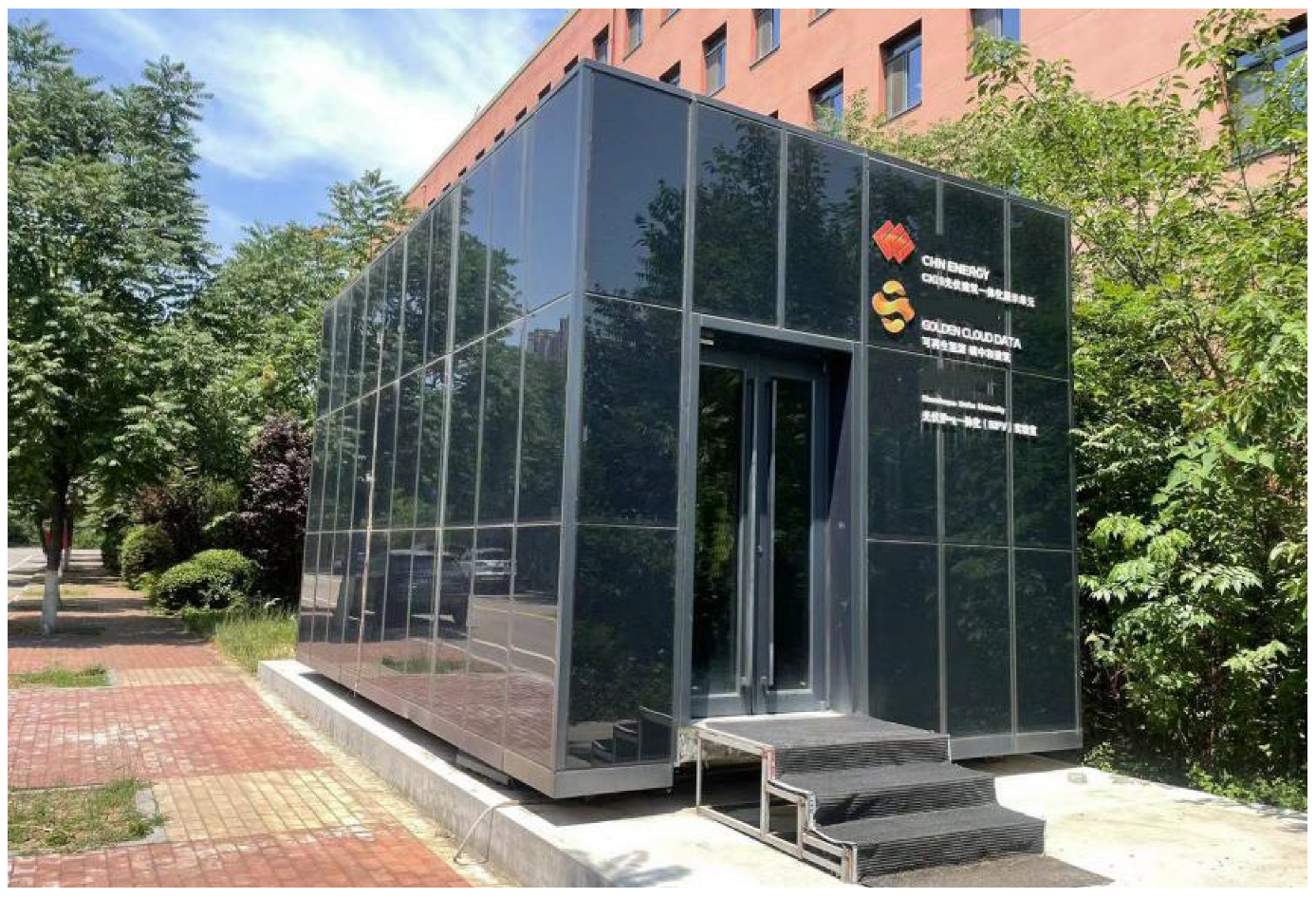
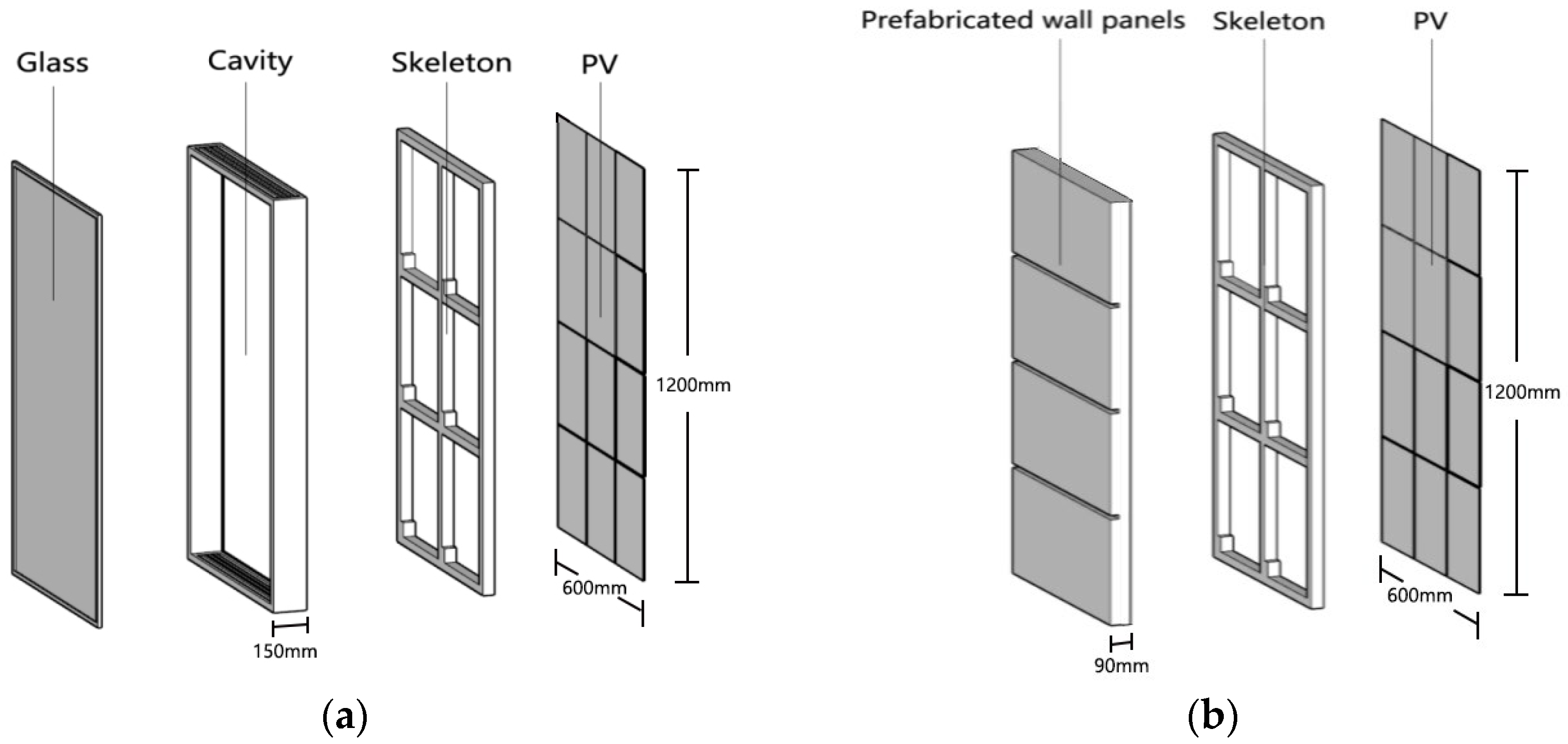

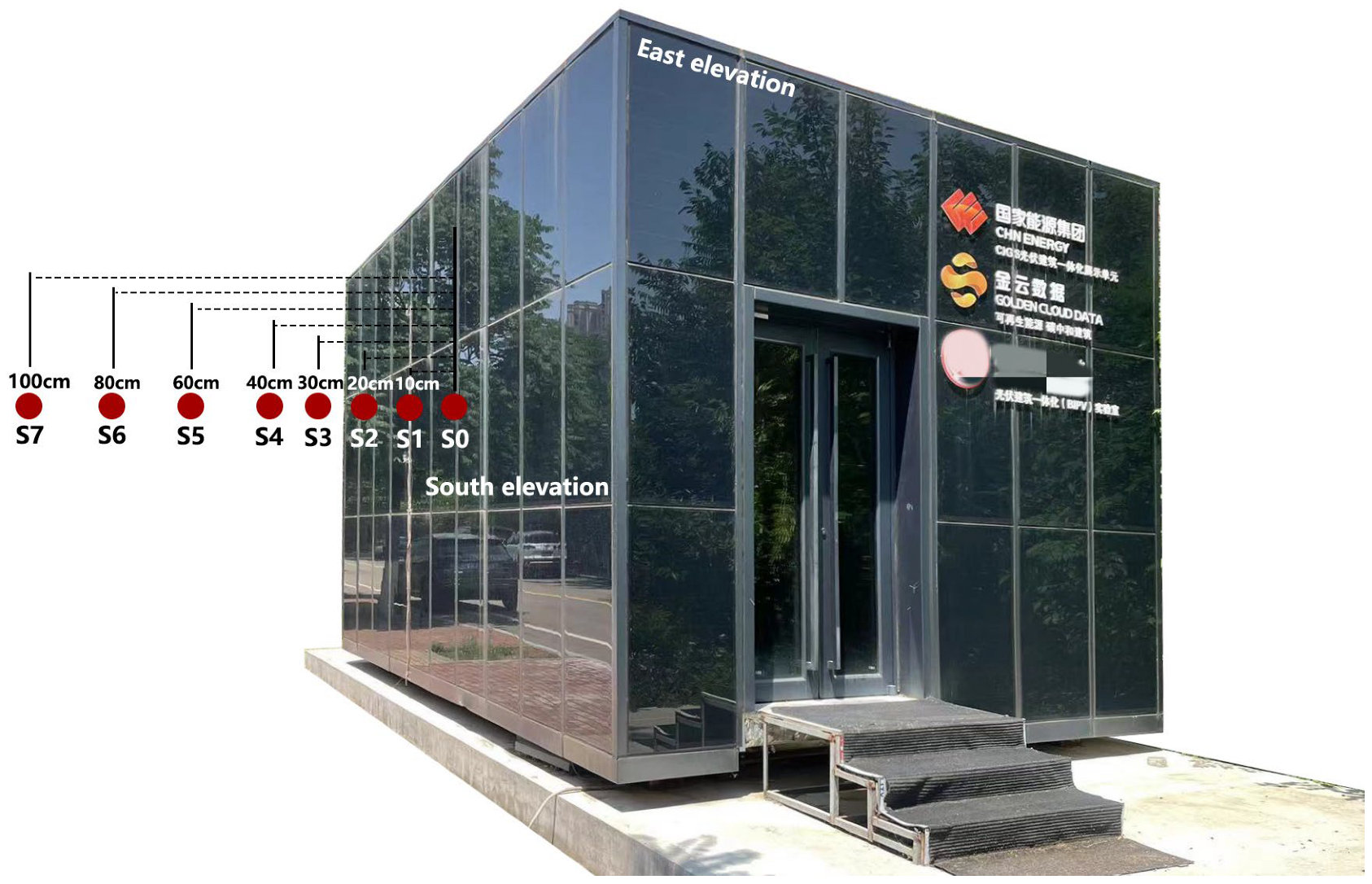
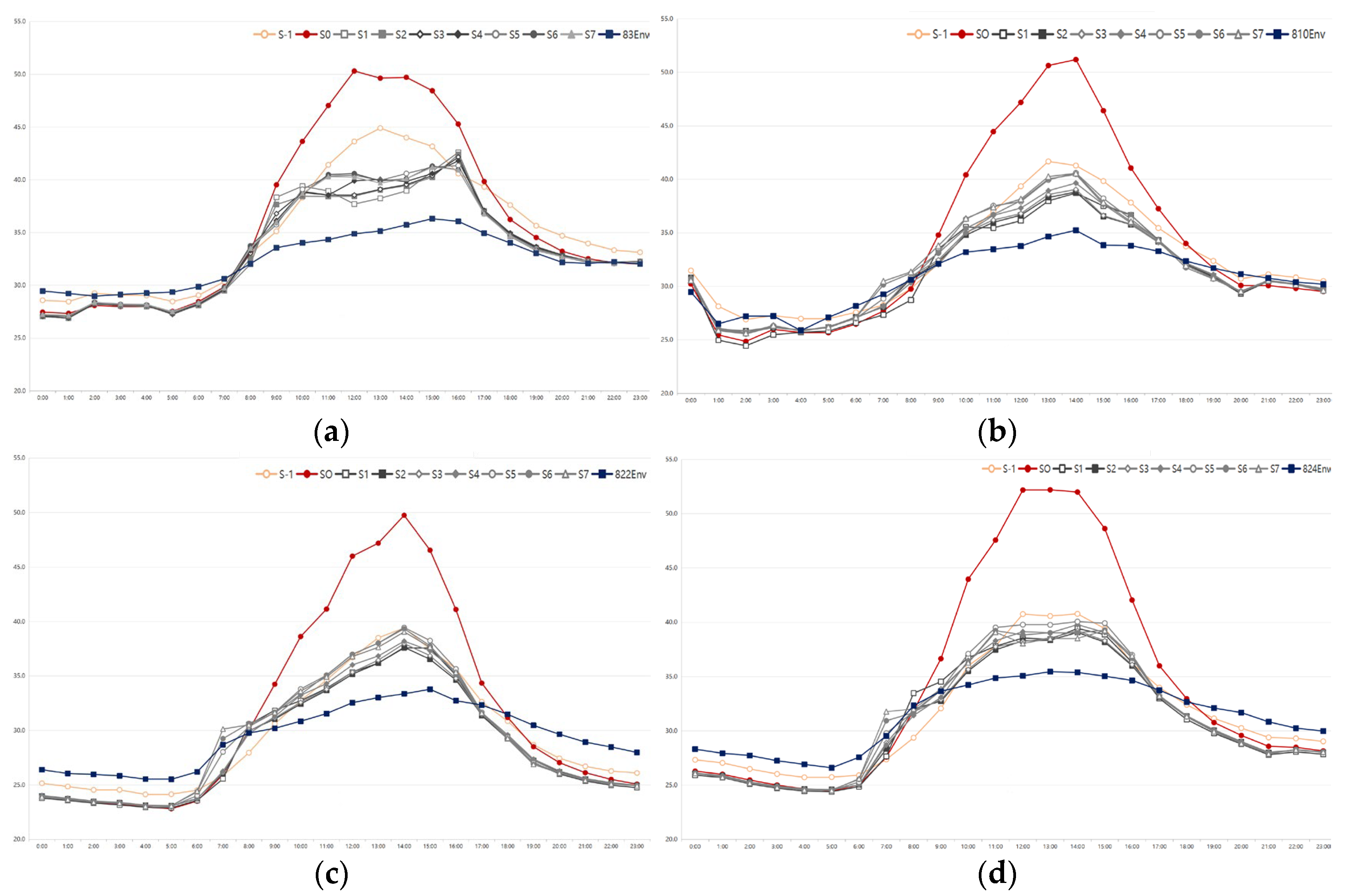





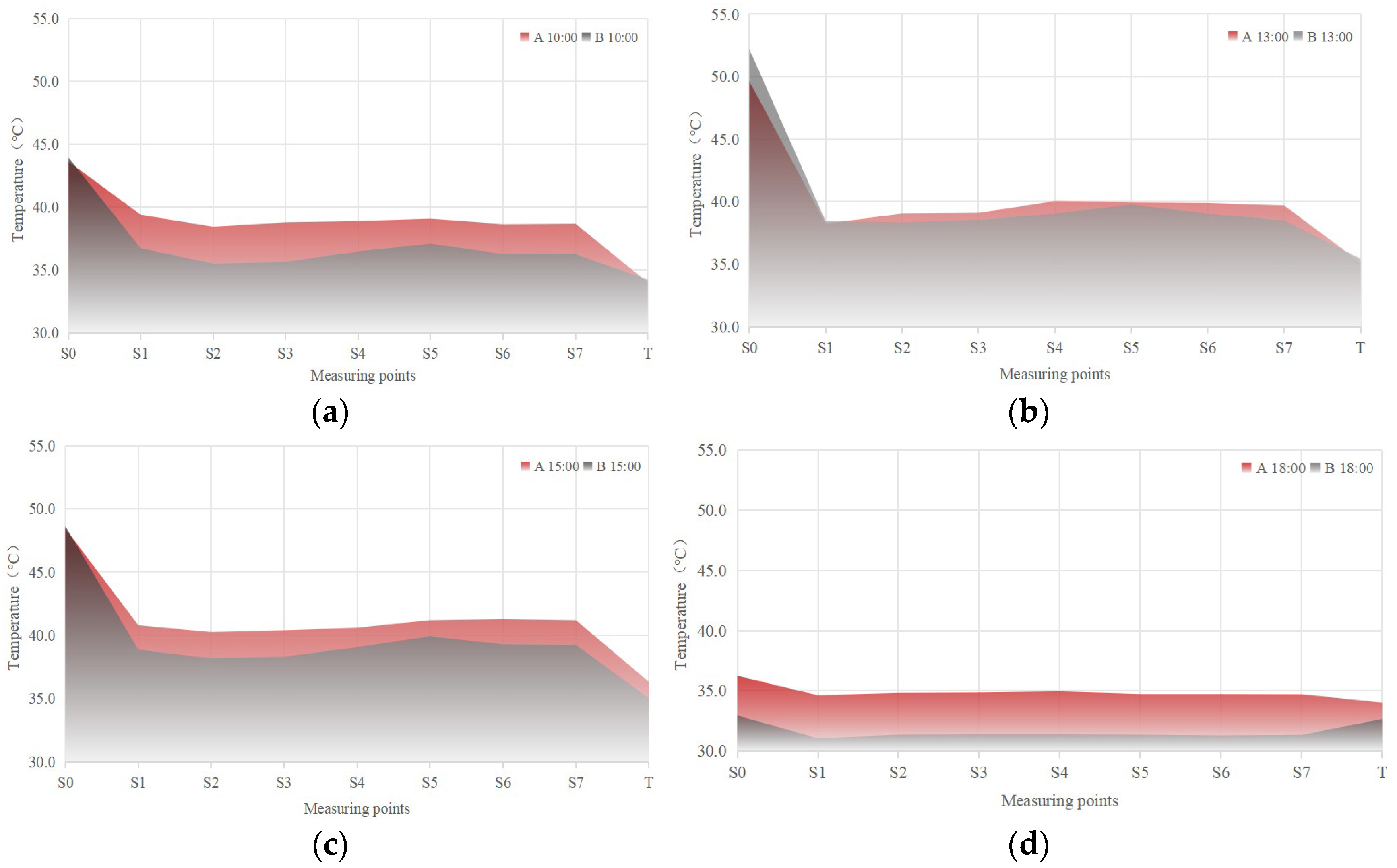

| Sensor Name | Measurement Parameter/Position | Unit | Accuracy | Range | Temporal Resolution |
|---|---|---|---|---|---|
| Outdoor weather station | Ambient air Temperature | ℃ | ±0.2 °C | −40~120 °C | 10 min |
| Wind velocity | m/s | ±0.3 m/s | 0.2~40.0 m/s | 10 min | |
| Wind direction | ° | / | / | 10 min | |
| Solar radiation | W/m2 | ±5% | 0~2000 W | 10 min | |
| Non-contact infrared thermometer | PV module surface temperature | °C | ±1% | 0~150 °C | 10 min |
| Temperature sensor | South elevation exterior temperature | °C | ±0.1 °C | −40~80 °C | 10 min |
| Measurement Point Location | Measured Parameters | Measurement Point Names |
|---|---|---|
| Outdoor | Temperature, wind speed, solar radiation | T, V, G |
| South-facing outer | Temperature | S1, S2, S3, S4, S5, S6, S7 |
| South elevation surface | Temperature | S0 |
| Date | Value | Categorization (Temperature–Radiation–Wind Speed) | |||
|---|---|---|---|---|---|
| Maximum Daytime Temperature (°C) | Average Daytime Temperature (°C) | Maximum Solar Radiation (W/m2) | Average Daytime Wind Speed (m/s) | ||
| 8.3 | 37.2 | 33.9 | 905 | 3.4 | High–high–high |
| 8.4 | 35.8 | 31.7 | 881 | 3.6 | Low–high–high |
| 8.10 | 35.7 | 32.5 | 872 | 2.5 | Medium–high–medium |
| 8.12 | 35.0 | 32.5 | 866 | 1.9 | Medium–medium–low |
| 8.22 | 35.0 | 31.2 | 869 | 1.6 | Low–medium–low |
| 8.23 | 35.5 | 32.9 | 844 | 1.4 | Medium–medium–low |
| 8.24 | 36.4 | 33.3 | 762 | 1.5 | High–low–low |
| S1 | S2 | S3 | S4 | S5 | S6 | S7 | |
|---|---|---|---|---|---|---|---|
| Typical day A | +4.0 | +4.0 | +4.0 | +4.0 | +4.0 | +3.0 | +3.0 |
| Typical day B | +2.0 | +2.0 | +2.0 | +2.0 | +2.0 | +3.0 | +3.0 |
| Distance Zone | Zone Temperature Difference | Temperature Performance | Temperature Gradient | Occurrence Frequency | Dominant Mechanism |
|---|---|---|---|---|---|
| Near surface (0~10 cm) | −10.46~−7.78 °C | Sharp temperature drop | −9.26/10 cm | 100% | Surface radiation heating and boundary layer forced convection |
| Short distance (10~40 cm) | 0.35~0.98 °C | Steady rise | +0.19 °C/10 cm | 63% | Stable convective heat transfer |
| Medium distance (40~80 cm) | −0.15~0.63 °C | Rise then fall | 0.05 °C/10 cm | 77% | Complex flow and heat accumulation effects |
| Long distance (≥80 cm) | −0.22~0.15 °C | Gradual decline | −0.02 °C/10 cm | 61% | Turbulent diffusion |
| Wind Speed Classification | Days | Average Ri Number | Ri Number Interval Frequency | ||
|---|---|---|---|---|---|
| Ri < 0.3 | 0.3 < Ri < 0.7 | Ri > 0.7 | |||
| High wind speed (v > 3 m/s) | 2 days | 0.19 | 100% | / | / |
| Medium wind speed (3 m/s > v > 2 m/s) | 1 day | 0.33 | <30% | >70% | / |
| Low wind speed (1 m/s < v) | 4 days | 0.87 | / | <45% | >55% |
| High wind speed (v > 3 m/s) | 2 days | 0.19 | 100% | / | / |
Disclaimer/Publisher’s Note: The statements, opinions and data contained in all publications are solely those of the individual author(s) and contributor(s) and not of MDPI and/or the editor(s). MDPI and/or the editor(s) disclaim responsibility for any injury to people or property resulting from any ideas, methods, instructions or products referred to in the content. |
© 2025 by the authors. Licensee MDPI, Basel, Switzerland. This article is an open access article distributed under the terms and conditions of the Creative Commons Attribution (CC BY) license (https://creativecommons.org/licenses/by/4.0/).
Share and Cite
Zhang, Y.; Mu, T.; Xue, Y. External Temperature Distribution and Characteristics of Building-Integrated Photovoltaics (BIPV) Under Summer High-Temperature Conditions. Buildings 2025, 15, 3415. https://doi.org/10.3390/buildings15183415
Zhang Y, Mu T, Xue Y. External Temperature Distribution and Characteristics of Building-Integrated Photovoltaics (BIPV) Under Summer High-Temperature Conditions. Buildings. 2025; 15(18):3415. https://doi.org/10.3390/buildings15183415
Chicago/Turabian StyleZhang, Yingge, Tian Mu, and Yibing Xue. 2025. "External Temperature Distribution and Characteristics of Building-Integrated Photovoltaics (BIPV) Under Summer High-Temperature Conditions" Buildings 15, no. 18: 3415. https://doi.org/10.3390/buildings15183415
APA StyleZhang, Y., Mu, T., & Xue, Y. (2025). External Temperature Distribution and Characteristics of Building-Integrated Photovoltaics (BIPV) Under Summer High-Temperature Conditions. Buildings, 15(18), 3415. https://doi.org/10.3390/buildings15183415










